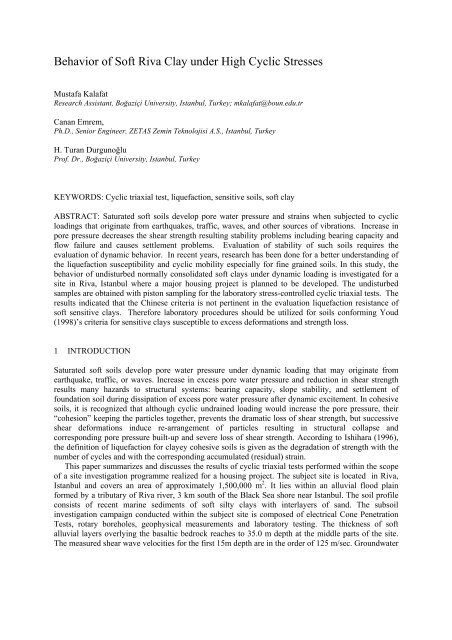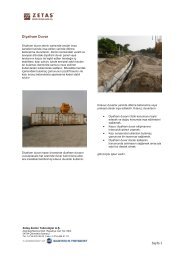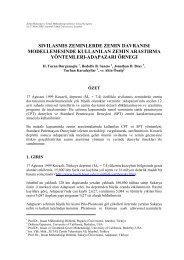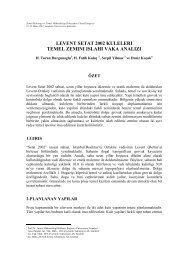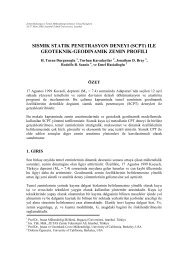a case study on soil improvement with heavy dynamic compaction
a case study on soil improvement with heavy dynamic compaction
a case study on soil improvement with heavy dynamic compaction
Create successful ePaper yourself
Turn your PDF publications into a flip-book with our unique Google optimized e-Paper software.
Behavior of Soft Riva Clay under High Cyclic StressesMustafa KalafatResearch Assistant, Boğaziçi University, Istanbul, Turkey; mkalafat@boun.edu.trCanan Emrem,Ph.D., Senior Engineer, ZETAS Zemin Teknolojisi A.S., Istanbul, TurkeyH. Turan DurgunoğluProf. Dr., Boğaziçi University, Istanbul, TurkeyKEYWORDS: Cyclic triaxial test, liquefacti<strong>on</strong>, sensitive <strong>soil</strong>s, soft clayABSTRACT: Saturated soft <strong>soil</strong>s develop pore water pressure and strains when subjected to cyclicloadings that originate from earthquakes, traffic, waves, and other sources of vibrati<strong>on</strong>s. Increase inpore pressure decreases the shear strength resulting stability problems including bearing capacity andflow failure and causes settlement problems. Evaluati<strong>on</strong> of stability of such <strong>soil</strong>s requires theevaluati<strong>on</strong> of <strong>dynamic</strong> behavior. In recent years, research has been d<strong>on</strong>e for a better understanding ofthe liquefacti<strong>on</strong> susceptibility and cyclic mobility especially for fine grained <strong>soil</strong>s. In this <str<strong>on</strong>g>study</str<strong>on</strong>g>, thebehavior of undisturbed normally c<strong>on</strong>solidated soft clays under <strong>dynamic</strong> loading is investigated for asite in Riva, Istanbul where a major housing project is planned to be developed. The undisturbedsamples are obtained <strong>with</strong> pist<strong>on</strong> sampling for the laboratory stress-c<strong>on</strong>trolled cyclic triaxial tests. Theresults indicated that the Chinese criteria is not pertinent in the evaluati<strong>on</strong> liquefacti<strong>on</strong> resistance ofsoft sensitive clays. Therefore laboratory procedures should be utilized for <strong>soil</strong>s c<strong>on</strong>forming Youd(1998)’s criteria for sensitive clays susceptible to excess deformati<strong>on</strong>s and strength loss.1 INTRODUCTIONSaturated soft <strong>soil</strong>s develop pore water pressure under <strong>dynamic</strong> loading that may originate fromearthquake, traffic, or waves. Increase in excess pore water pressure and reducti<strong>on</strong> in shear strengthresults many hazards to structural systems: bearing capacity, slope stability, and settlement offoundati<strong>on</strong> <strong>soil</strong> during dissipati<strong>on</strong> of excess pore water pressure after <strong>dynamic</strong> excitement. In cohesive<strong>soil</strong>s, it is recognized that although cyclic undrained loading would increase the pore pressure, their“cohesi<strong>on</strong>” keeping the particles together, prevents the dramatic loss of shear strength, but successiveshear deformati<strong>on</strong>s induce re-arrangement of particles resulting in structural collapse andcorresp<strong>on</strong>ding pore pressure built-up and severe loss of shear strength. According to Ishihara (1996),the definiti<strong>on</strong> of liquefacti<strong>on</strong> for clayey cohesive <strong>soil</strong>s is given as the degradati<strong>on</strong> of strength <strong>with</strong> thenumber of cycles and <strong>with</strong> the corresp<strong>on</strong>ding accumulated (residual) strain.This paper summarizes and discusses the results of cyclic triaxial tests performed <strong>with</strong>in the scopeof a site investigati<strong>on</strong> programme realized for a housing project. The subject site is located in Riva,Istanbul and covers an area of approximately 1,500,000 m 2 . It lies <strong>with</strong>in an alluvial flood plainformed by a tributary of Riva river, 3 km south of the Black Sea shore near Istanbul. The <strong>soil</strong> profilec<strong>on</strong>sists of recent marine sediments of soft silty clays <strong>with</strong> interlayers of sand. The sub<strong>soil</strong>investigati<strong>on</strong> campaign c<strong>on</strong>ducted <strong>with</strong>in the subject site is composed of electrical C<strong>on</strong>e Penetrati<strong>on</strong>Tests, rotary boreholes, geophysical measurements and laboratory testing. The thickness of softalluvial layers overlying the basaltic bedrock reaches to 35.0 m depth at the middle parts of the site.The measured shear wave velocities for the first 15m depth are in the order of 125 m/sec. Groundwater
table is at a depth of 0.5 m below the ground surface. The site is <strong>with</strong>in the sec<strong>on</strong>d degree (sec<strong>on</strong>dhighest risk group) earthquake z<strong>on</strong>e according to 1998 earthquake specificati<strong>on</strong> of Turkey. The cyclictriaxial testing programme is planned towards a better understanding of the <strong>soil</strong> behaviour underpossible seismic loading. Therefore in order to investigate the effect of <strong>dynamic</strong> excitement <strong>on</strong> theexcess pore water development and <strong>dynamic</strong> shear modulus for clays, a series of cyclic undrainedtriaxial tests were performed <strong>on</strong> Riva clay.2 SAMPLING AND TESTING PROCEDURES2.1 Field sampling and preparati<strong>on</strong> for testingUndisturbed <strong>soil</strong> samples have been obtained in the course of borings at the site. All samples havebeen retrieved from the field by means of fixed pist<strong>on</strong> samplers (Andresen and Kolstad, 1979).Sampling tubes having an internal diameter of D=54mm were carefully cleaned and checked fordefects before use. After retrieval of the sample, a preliminary identificati<strong>on</strong> was d<strong>on</strong>e, and then theends of the tube were covered <strong>with</strong> paraffin to preserve the original moisture c<strong>on</strong>tent. Tubes arecarefully handled not to induce disturbing vibrati<strong>on</strong>s during transportati<strong>on</strong> to the laboratory.In the laboratory, samples were extracted from the tubes by a vertical oil pist<strong>on</strong> sample extruder.Trimming was avoided to prevent disturbance. Vacuum saturati<strong>on</strong> and back pressure saturati<strong>on</strong>procedures were utilized successively to ensure saturati<strong>on</strong>. For all samples a B value of at least 0.98was achieved.For the project site, a fill of 2m thickness is proposed to be built. Therefore all samples areisotropically c<strong>on</strong>solidated bey<strong>on</strong>d in situ stresses prior to testing to decrease the effect of disturbance,to represent the effect of the fill, and to make sure that sample is normally c<strong>on</strong>solidated. In thecalculati<strong>on</strong> of mean c<strong>on</strong>fining stress (σ′ m ), lateral earth pressure coefficient at rest was taken as 0.55.Accordingly σ′ m can be written as:( K σ )σ′ + 2⋅ ⋅ ′′ = ′ = = ⋅vo3′ (1)vo0 voσmσ3c0.7 σ2.2 Cyclic Triaxial testingCyclic triaxial tests are often used to determine <strong>soil</strong> behaviour under <strong>dynamic</strong> loading in thelaboratory. In this <str<strong>on</strong>g>study</str<strong>on</strong>g>, stress c<strong>on</strong>trolled cyclic tests were performed <strong>on</strong> CKC Automatic CyclicTriaxial Testing setup (Li et al 1988). The equipment is able to perform back pressure saturati<strong>on</strong>, Bvalue check, c<strong>on</strong>solidati<strong>on</strong> (isotropic, anisotropic, and K 0 ), m<strong>on</strong>ot<strong>on</strong>ic and cyclic loading both drainedand undrained under stress or strain c<strong>on</strong>trol. During the tests, time, deviator stress, axial strain, cellpressure, effective pressure, and volumetric strain were automatically measured and recorded byequipment using the three pressure transducers, <strong>on</strong>e load cell and <strong>on</strong>e LVDT. A sample test output canbe seen in Figure 1.After saturati<strong>on</strong> and c<strong>on</strong>solidati<strong>on</strong> phase, cyclic deviator stresses (σ d-cyc ) were applied at 1Hzfrequency. In this <str<strong>on</strong>g>study</str<strong>on</strong>g>, cyclic stress ratio for specimens tested in triaxial test setup (CSR tx ) is definedas the ratio of cyclic shear stress <strong>on</strong> the sample (σ d-cyc /2) to effective mean c<strong>on</strong>solidati<strong>on</strong> stress (σ′ m ).Since all of the samples are isotropically c<strong>on</strong>solidated (no initial shear stress <strong>on</strong> the sample), CSR txbecomes:CSRtxσ−=2 ⋅σ′d cyc3c(2)
where σ′ 3c is effective lateral c<strong>on</strong>solidati<strong>on</strong> pressure. Due to differences in the stress path and thenature of laboratory testing procedures, cyclic stress ratio are corrected as CSR triaxial = 0.9⋅c r ⋅CSR field ,where the average value of the correcti<strong>on</strong> factor c r is 0.7 for various normally c<strong>on</strong>solidated finegrained <strong>soil</strong>s (Boulanger et al. 1998).3 RESULTS OF THE CYCLIC TRIAXIAL TESTSA total of eight cyclic undrained triaxial tests were performed <strong>on</strong> silty clays obtained from sevendifferent sample tubes. Plasticity, water c<strong>on</strong>tent, sieve analysis, and hydrometer tests were performedfor each sample. Index properties of the samples and in situ test results are summarized inTable 1.3.1 Cyclic strengthIn this paper the triggering of liquefacti<strong>on</strong> is represented in terms of number of uniform, c<strong>on</strong>stantamplitude cycles required to reach <strong>on</strong>e of the following c<strong>on</strong>diti<strong>on</strong>s during the test: 3% singleamplitude axial strain, 5% double amplitude axial strain or zero effective lateral stress. C<strong>on</strong>solidati<strong>on</strong>pressure, cyclic deviator stress, cyclic stress ratio, and number of cycles required to reach liquefacti<strong>on</strong>c<strong>on</strong>diti<strong>on</strong> for each test are summarized in Table 2.The variati<strong>on</strong> of cyclic strength (N f , number of cycles to failure) <strong>with</strong> respect to CSR tx is shown inFigure 2. N f is selected as the minimum of number of cycles required to produce cyclic liquefacti<strong>on</strong>. Itcould be seen from this figure that the cyclic liquefacti<strong>on</strong> c<strong>on</strong>diti<strong>on</strong> was reached in all tests except <strong>on</strong>esample <strong>with</strong> high plasticity values (i.e. LL=72, PI=38).Figure 1. An output log for test 4.
3.2 Pore water pressure developmentWhen soft clays are loaded cyclically, they generate excess pore water pressure. Residual cyclic porewaterpressure ratio at cycle N is defined as:u*N∆u=σ ′Development of residual pore water pressure is plotted in Figure 3. The amount of developed porewater pressure increases <strong>with</strong> increasing number of cycles and amplitude of loading as could be seenfrom the figure. The relati<strong>on</strong> between ∆u N and log(N) is approximately linear. However it is knownthat pore pressure measurements are difficult in cyclic testing of materials <strong>with</strong> low permeability(Perlea, 2000). It is also generally observed during the testing that the cyclic strain increasessignificantly before the excess pore water pressure reaches the initial c<strong>on</strong>fining stress level.N3c(3)Table 1. Properties of the test samplesTestNo*USCSDepth(m)Z gwt(m)LL(%)PI(%)ω n(%)FC(%)
CSRtx0.70.60.50.40.3PI: 21-25PI: 26-30PI: 31-35PI: 36-401 10 100N f , Number of cycles to failureu*, excess pwp ratio0.80.60.40.20.01 CSR=0,592 CSR=0,443 CSR=0,424 CSR=0,356 CSR=0,357 CSR=0,578 CSR=0,379 CSR=0,381 10 100 1000N, number of cyclesFigure 2. Number of cycles required to reachfailure c<strong>on</strong>diti<strong>on</strong>Figure 3. Generati<strong>on</strong> of residual pore water pressure3.3 Degradati<strong>on</strong> of <strong>dynamic</strong> shear modulusDuring cyclic loading of the <strong>soil</strong>s, the <strong>dynamic</strong> shear modulus decreases as the number of cyclesincreases. Cyclic degradati<strong>on</strong> index, δ is defined by Idriss et al. (1978) as the ratio of <strong>dynamic</strong> shearmodulus at any cycle, G N to <strong>dynamic</strong> shear modulus at the first cycle, G 1 (initial <strong>dynamic</strong> shearmodulus) and it depends <strong>on</strong> the amplitude of the cyclic loading. In <str<strong>on</strong>g>case</str<strong>on</strong>g> of stress c<strong>on</strong>trolled tests are tobe utilized, degradati<strong>on</strong> index can be written as:δGτ γ γN cyc N 1N= = = (4)G1 τcycγ1γNwhere G=E/[2(1+ν)], γ=ε/(1+ν), and ν=0.5 for saturated soft clays. According to the performed cyclictriaxial tests degradati<strong>on</strong> of <strong>dynamic</strong> shear modulus of Riva clay is shown in Figure 4. As seen fromthe figure G N appears to be the functi<strong>on</strong> of CSR and PI. G N increases <strong>with</strong> decreasing CSR andincreasing PI. Liquefacti<strong>on</strong> c<strong>on</strong>diti<strong>on</strong> was reached when G N dropped to 0.7-0.9 MPa. In Figure 5,variati<strong>on</strong> of degradati<strong>on</strong> parameter is plotted. For Riva clay, the relati<strong>on</strong>ship between δ and log(N) isobtained as approximately linear.4 IMPLICATIONS AND CONCLUDING REMARKSSeed and Idriss (1982) developed a criteria called as Chinese criteria for clayey <strong>soil</strong>s subjected toliquefacti<strong>on</strong> based <strong>on</strong> the data obtained from the earthquakes in China. According to these criteria aclayey <strong>soil</strong> can liquefy under seismic loading if all of the following c<strong>on</strong>diti<strong>on</strong>s are satisfied :• Particles finer than 5µm < 15%• LL < 35%• ω n / LL > 0.9According to the results of the performed cyclic triaxial tests, Riva clay under <str<strong>on</strong>g>study</str<strong>on</strong>g> did notc<strong>on</strong>form <strong>with</strong> the Chinese criteria as could be seen from the Figure 6. Youd (1998) stated that theChinese criteria are reliable for predicting liquefacti<strong>on</strong> of fine grained sediments but are generallyc<strong>on</strong>servative. However, the criteria do not work for sensitive <strong>soil</strong>s. Thus, the plastic and clayey <strong>soil</strong>s
Dynamic shear modulus [kPa]250020001500100050001 CSR=0,592 CSR=0,443 CSR=0,424 CSR=0,356 CSR=0,357 CSR=0,578 CSR=0,379 CSR=0,381 10 100 1000N, number of cyclesδ, degradati<strong>on</strong> index1.00.90.80.70.60.50.40.30.20.10.01 CSR=0,592 CSR=0,443 CSR=0,424 CSR=0,356 CSR=0,357 CSR=0,578 CSR=0,379 CSR=0,381 10 100 1000N, number of cyclesFigure 4. Variati<strong>on</strong> of <strong>dynamic</strong> shear modulus <strong>with</strong>number of cyclesFigure 5. Variati<strong>on</strong> of degradati<strong>on</strong> index.80Liquid limit [%]70605040SAFE3020LIQUEFACTIONSUSCEPTIBLEif particles finer than 5µ < 15%20 30 40 50 60 70 80 90 100Natural water c<strong>on</strong>tent [%]Figure 6. Evaluati<strong>on</strong> of chinese criteriaare also susceptible to liquefacti<strong>on</strong> if they are sensitive and may develop excess deformati<strong>on</strong>s andloose strength during the earthquakes. Youd (1998) proposed the criteria as shown in the sec<strong>on</strong>dcolumn of the Table 3 for detecting the sensitivity for seismically induced strength loss. As could beseen from the third column <strong>on</strong> the same Table, Riva clay c<strong>on</strong>forms <strong>with</strong> these criteria.Sancio et al. (2003) have found based <strong>on</strong> a large number of cyclic triaxial tests performed <strong>on</strong>“undisturbed” specimens of Adapazari that the <strong>soil</strong>s <strong>with</strong> PI>12, which generally have LL>35 cangenerate significant strains in a small number of cycles when a high CSR is applied <strong>on</strong> the c<strong>on</strong>trary ofthe Chinese criteria. It is noted that the laboratory testing is essential for the soft silty clays <strong>with</strong> highplasticity to assess the cyclic liquefacti<strong>on</strong> susceptibility.
Table 3. Youd (1998)’s Criteria for sensitive clays subjected to excessive deformati<strong>on</strong> andstrength loss during/after seismic excitati<strong>on</strong>Criteria Youd (1998) Riva claySoil Types CL or ML CL, CHSensitivity >4 5-12Liquidity index >0.6 0.6-1.6Moisture c<strong>on</strong>tent >0.9xLL (0.8-1.3)xLLPenetrati<strong>on</strong> resistance (N 1 ) 60


